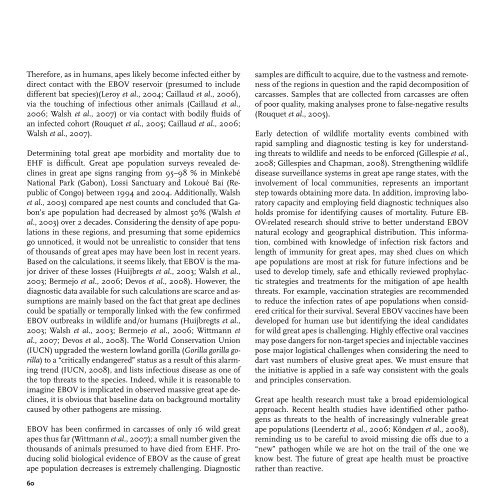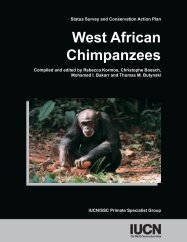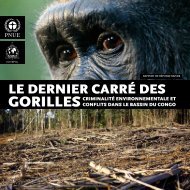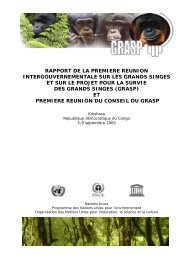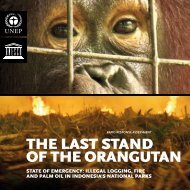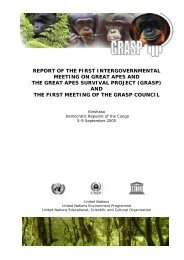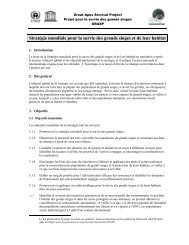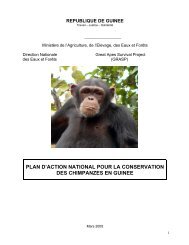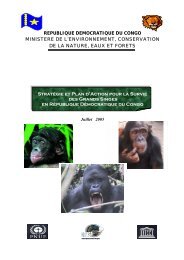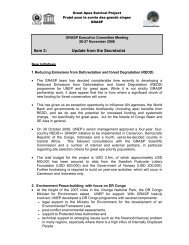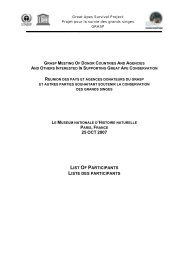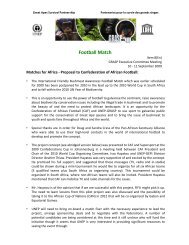THE LAST STAND OF THE - GRASP
THE LAST STAND OF THE - GRASP
THE LAST STAND OF THE - GRASP
Create successful ePaper yourself
Turn your PDF publications into a flip-book with our unique Google optimized e-Paper software.
Therefore, as in humans, apes likely become infected either by<br />
direct contact with the EBOV reservoir (presumed to include<br />
different bat species)(Leroy et al., 2004; Caillaud et al., 2006),<br />
via the touching of infectious other animals (Caillaud et al.,<br />
2006; Walsh et al., 2007) or via contact with bodily fluids of<br />
an infected cohort (Rouquet et al., 2005; Caillaud et al., 2006;<br />
Walsh et al., 2007).<br />
Determining total great ape morbidity and mortality due to<br />
EHF is difficult. Great ape population surveys revealed declines<br />
in great ape signs ranging from 95–98 % in Minkebé<br />
National Park (Gabon), Lossi Sanctuary and Lokoué Bai (Republic<br />
of Congo) between 1994 and 2004. Additionally, Walsh<br />
et al., 2003) compared ape nest counts and concluded that Gabon’s<br />
ape population had decreased by almost 50% (Walsh et<br />
al., 2003) over 2 decades. Considering the density of ape populations<br />
in these regions, and presuming that some epidemics<br />
go unnoticed, it would not be unrealistic to consider that tens<br />
of thousands of great apes may have been lost in recent years.<br />
Based on the calculations, it seems likely, that EBOV is the major<br />
driver of these losses (Huijbregts et al., 2003; Walsh et al.,<br />
2003; Bermejo et al., 2006; Devos et al., 2008). However, the<br />
diagnostic data available for such calculations are scarce and assumptions<br />
are mainly based on the fact that great ape declines<br />
could be spatially or temporally linked with the few confirmed<br />
EBOV outbreaks in wildlife and/or humans (Huijbregts et al.,<br />
2003; Walsh et al., 2003; Bermejo et al., 2006; Wittmann et<br />
al., 2007; Devos et al., 2008). The World Conservation Union<br />
(IUCN) upgraded the western lowland gorilla (Gorilla gorilla gorilla)<br />
to a “critically endangered” status as a result of this alarming<br />
trend (IUCN, 2008), and lists infectious disease as one of<br />
the top threats to the species. Indeed, while it is reasonable to<br />
imagine EBOV is implicated in observed massive great ape declines,<br />
it is obvious that baseline data on background mortality<br />
caused by other pathogens are missing.<br />
EBOV has been confirmed in carcasses of only 16 wild great<br />
apes thus far (Wittmann et al., 2007); a small number given the<br />
thousands of animals presumed to have died from EHF. Producing<br />
solid biological evidence of EBOV as the cause of great<br />
ape population decreases is extremely challenging. Diagnostic<br />
samples are difficult to acquire, due to the vastness and remoteness<br />
of the regions in question and the rapid decomposition of<br />
carcasses. Samples that are collected from carcasses are often<br />
of poor quality, making analyses prone to false-negative results<br />
(Rouquet et al., 2005).<br />
Early detection of wildlife mortality events combined with<br />
rapid sampling and diagnostic testing is key for understanding<br />
threats to wildlife and needs to be enforced (Gillespie et al.,<br />
2008; Gillespies and Chapman, 2008). Strengthening wildlife<br />
disease surveillance systems in great ape range states, with the<br />
involvement of local communities, represents an important<br />
step towards obtaining more data. In addition, improving laboratory<br />
capacity and employing field diagnostic techniques also<br />
holds promise for identifying causes of mortality. Future EB-<br />
OV-related research should strive to better understand EBOV<br />
natural ecology and geographical distribution. This information,<br />
combined with knowledge of infection risk factors and<br />
length of immunity for great apes, may shed clues on which<br />
ape populations are most at risk for future infections and be<br />
used to develop timely, safe and ethically reviewed prophylactic<br />
strategies and treatments for the mitigation of ape health<br />
threats. For example, vaccination strategies are recommended<br />
to reduce the infection rates of ape populations when considered<br />
critical for their survival. Several EBOV vaccines have been<br />
developed for human use but identifying the ideal candidates<br />
for wild great apes is challenging. Highly effective oral vaccines<br />
may pose dangers for non-target species and injectable vaccines<br />
pose major logistical challenges when considering the need to<br />
dart vast numbers of elusive great apes. We must ensure that<br />
the initiative is applied in a safe way consistent with the goals<br />
and principles conservation.<br />
Great ape health research must take a broad epidemiological<br />
approach. Recent health studies have identified other pathogens<br />
as threats to the health of increasingly vulnerable great<br />
ape populations (Leendertz et al., 2006; Köndgen et al., 2008),<br />
reminding us to be careful to avoid missing die offs due to a<br />
“new” pathogen while we are hot on the trail of the one we<br />
know best. The future of great ape health must be proactive<br />
rather than reactive.<br />
60


